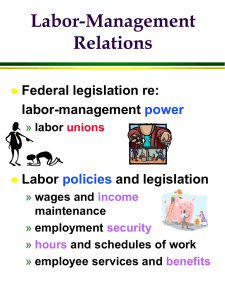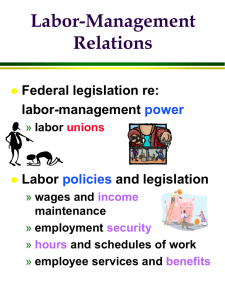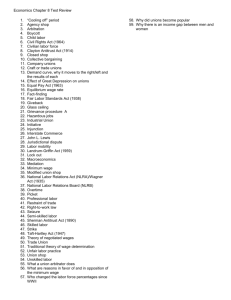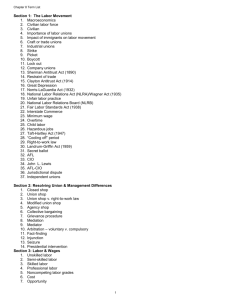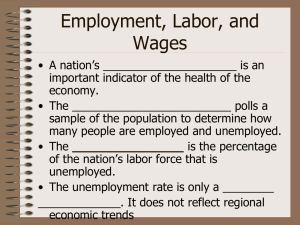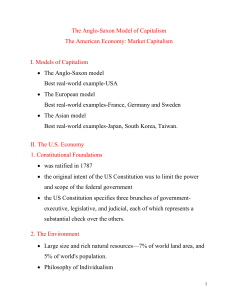Public Finance - Marietta College
advertisement
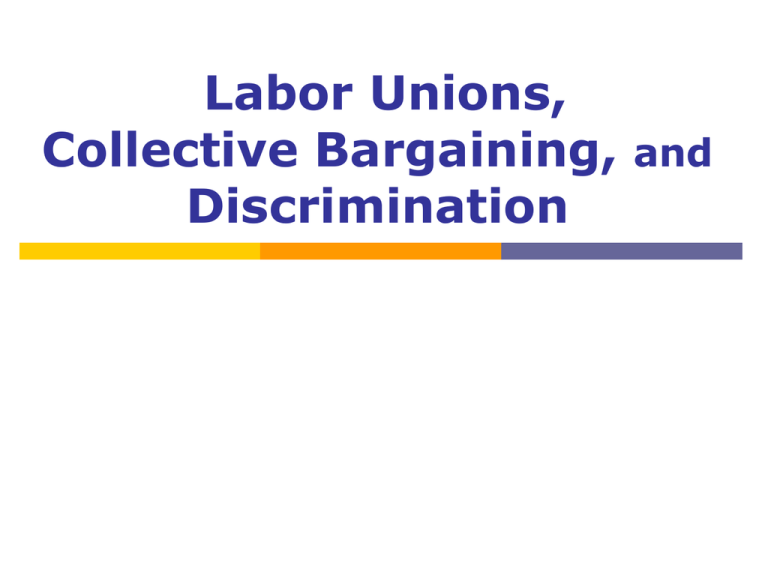
Labor Unions, Collective Bargaining, and Discrimination Why Unions? Union Membership by Industry, 2008 Union Membership by Occupation, 2008 Sales Workers Managers Clerical Workers Service Workers Production Install and Repair Transportation Professional and Technical Construction 0 5 10 Percent Union Membership 15 20 Union Membership by Public Sector Status, 2008 Union Membership by Demographic Group, 2008 Unionization by State 11.3 13.5 12.9 21.0 13.1 8.0 7.2 16.8 7.2 14.7 25.4 16.1 20.4 10.0 9.5 14.0 6.1 15.5 5.2 11.2 11.9 16.9 12.2 13.0 9.3 8.6 11.4 15.5 17.2 17.0 14.7 4.1 6.8 7.7 4.2 5.8 9.7 6.0 11.5 7.2 7.3 10.0 6.5 5.9 23.8 25.9 CT 16.5 MA 15.3 MD 14.8 NJ 21.6 RI 16.0 Unionism’s Rise and Fall Percent Union Membership 35 30 25 20 15 10 5 0 1880 1900 1920 1940 1960 1980 2000 Labor Law Primer Clayton Act (1914) exempted unions from Sherman Act Railway Labor Act (1926) mandated collective bargaining in RR, Airlines Norris-LaGuardia Act (1932) Restricted use of yellow-dog contracts Restricted use of injunctions by firms Wagner Act (NLRA; 1935) Established right to organize and CB Defined ULP by firms Created NLRB Strikes by federal workers made illegal Taft-Hartley Act (1947) Defined ULP by unions Outlawed closed shops Created FMCS Unionism’s Decline Change in labor laws Structural Hypothesis Shift to services Globalization Shift to sunbelt Smaller firms Demographics: women, young Part-time work Managerial Opposition Hypothesis Reagan and PATCO Substitution Hypothesis Growth of gov’t provided benefits Models of Union Behavior Competitive market: W0, L0 I1 Economic models: Maximizers Wage rates? Employment? Wage bill? Monopoly union Efficient contracts I2 S Wu W0 π1 D Lu L0 Labor Strategies to Raise Union Wages Increase Labor Demand Increase Increase Increase Increase Tariffs on foreign goods product demand worker productivity price of substitutes Minimum wage/Davis-Bacon number of employers Domestic content laws Decrease Labor Supply Decrease immigration Decrease entry into occupation Increase nonwage income Apprenticeships/Licensing Social Security benefits Why Do Strikes Occur? $ Employer Concession W* Union Resistance t* Expected Strike Length Accident Model Misperceptions regarding other’s concession curve Asymmetric Information Models Info gap between union leadership and membership Info gap between union and firm Economic Impact of Unions Wage advantage Efficiency and productivity Profitability Distribution of earnings Macroeconomic effects Union Wage Advantage Pure wage advantage = (Wu – Wn)/Wn Union Wage Advantage SU SN WU SN Sspill WT W N W D LU L N Union sector S D LN LS Non-Union sector Spillover effect: laid-off union workers spill over into non-union sector Threat effect: non-union firms pay higher wages (WT) to deter union Product market effect: shift consumer demand to non-union markets Wait unemployment effect: mitigates spillover effect Superior worker effect: firms hire better workers CWD effect: unions jobs have fewer amenities Union Wage Advantage Efficiency and Productivity Negative view Restrictive work rules Strikes Labor misallocation Estimate: 0.10 percent of GDP is lost ($14 billion or $46 per person) Number of W Strikes Involving 1000+ Workers Since WU > N, we know that MRPU > MRPN Number of Workers Involved in Strikes with 1000+ Workers Number of Work Days Lost Days Lost (millions) Number of Workers (thousands) 500 Positive view 3000 45070 Collective voice 2500 60 400 Improve info flow 35050 2000 Increase morale through team effort 300 40 Reduce turnover 250 1500 30 Provide OTJ 200 Empirical evidence regarding the impact 1000 20 Technological progress 150 of unions on productivity is mixed capital substitution 10 100 500 50 0 0 01947 1952 1957 1962 1967 1972 1977 1982 1987 1992 1997 2002 2007 1947 1952 1952 1957 1957 1962 1962 1967 1967 1972 1972 1947 1977 1977 1982 1982 1987 1987 1992 1992 1997 1997 2002 2002 2007 Firm Profitability Nearly all studies find that unions reduce profits. Voos and Mishell (1986): unionization causes 20% to 23% reduction in profits If unions reduce profits in monopolistic industries, then no efficiency loss occurs. If unions reduce profits in competitive industries, then an efficiency loss occurs since firms will leave the industry. (Output will be lower and prices higher) The empirical evidence is mixed on whether there is an efficiency loss. Distribution of Earnings Increasing inequality Spillover effect lowers non-union wages Increase wages of skilled blue-collar workers relative to unskilled blue-collar workers Decrease inequality Equalize wages within firms Equalize wages across firms Reduce the white-collar/blue-collar differential Empirical evidence is that unions reduce earnings inequality on net Macroeconomic Effects Inflation Unions are not a cause of inflation Unemployment Unions may reduce downward wage flexibility increases unemployment Reduce worker turnover decreases unemployment High union wages may increase unemployment by attracting new entrants Empirical evidence is that unions have only a small effect on unemployment Demographic Differences in Labor Market Outcomes Gender Race 100% 90% 80% 70% 60% 50% 40% 30% 20% 10% 0% 1975 Female/Male Earnings Ratio ”If your valuation is of the male from twenty years even to sixty years old, then your valuation shall be fifty shekels of silver, after the shekel of the sanctuary. Or if it is a female, then your valuation shall be thirty shekels.” Leviticus 27:3-4 1980 1985 1990 1995 2000 2005 2010 Black/White Earnings Ratio Unemployment Rates 25% 20% 15% 10% 5% 0% 1975 White Male 1980 1985 1990 White Female 1995 2000 Black Male 2005 2010 Black Female Earnings by Education, Race, and Sex, 2007 Occupational Distribution by Gender, 2008 Occupational Distribution by Race, 2008 Educational Attainment, 2007 Labor Market Discrimination Wage discrimination Employment discrimination Occupational discrimination Human Capital discrimination Taste for Discrimination Model Gary Becker (1957) Society is willing to forgo output and profit to engage in discrimination Employers Employees Customers Discrimination coefficient: d = psychic costs Hiring Rule: MRP = W Assume: MRPw = MRPb University of Chicago 1992 Nobel Prize in Economics Prejudiced employer will be indifferent if: Ww = Wb + d Ex: Ww = $10 and d = 3 Wb = $7 Implies that: Wb < Ww Taste for Discrimination Model Wb/Ww The demand for black workers is formed by arraying employers from lowest to highest discrimination coefficients. Sb 1.00 Non-discriminators 0.80 Competitive markets should force discriminators to go bankrupt Db L1 Number of Black Workers A decrease in discrimination will lengthen the horizontal portion of the demand curve and reduce the slope of the downward sloping portion. The size of the black-wage gap varies directly with the supply of black labor. Measuring Discrimination: Residual Approach $ White Wage Function Assume: Blacks receive lower wages for any given E Blacks have less education than whites $500 = W W $420 = W*B Due to discrimination Black Wage Function $300 = W B EB WW – WB = observed wage gap = 500 – 300 = 200 Ww – W*B = explained wage gap = 500 – 420 = 80 W*B – WB = unexplained wage gap = 420 – 300 = 120 EW “residual” Education Mean Values of Worker Characteristics and Percentage of Wage Gap Explained White Men Black Men Hispanic Men White Women Black Women Hispanic Women Years of formal education 13.4 12.4 10.0 13.1 12.7 10.9 Years of experience 19.4 19.0 17.8 19.0 18.7 17.6 Percent Full-time employed 76.0 71.0 76.0 61.0 68.0 61.0 3.9 5.0 3.6 2.5 3.7 2.3 $23,279 $17,117 $16,291 $14,006 $13,873 $11,963 Percentage of wage gap explained 81 99 72 70 78 Percentage of wage gap unexplained 19 1 28 30 22 Percent Represented by Union Annual Earnings Source: Based on Garey Durden and Patricia Gaynor, “More on the Cost of Being Other Than White and Male: Measurement of Race, Ethnic, and Gender Effects on Yearly Earnings,” American Journal of Economics and Sociology 57 (January 1998), Table 1 and unpublished tables. Statistical Discrimination Model Occurs when individual is judged on basis of the average characteristics of a group Results from imperfect information used during the screening process number Marietta College Harvard GMC GH GRE scores Employer is not harmed by SD—it is an efficient response to imperfect information—therefore SD can persist.
